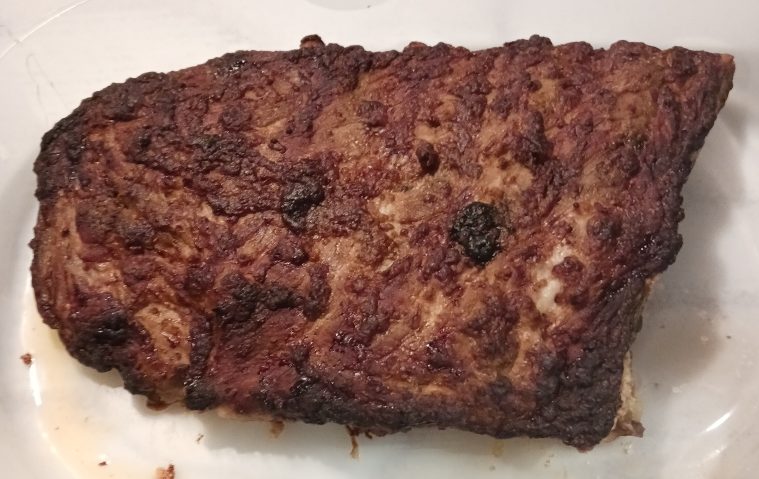
09/17/2023 – Joe, why are we being confronted by a half rack of Saint Louis ribs in a plastic container? Well, it has been a couple of tough days, and I knew you would want me to share.
Trouble arrived first in the form of a ten minute haircut. TEN MINUTES! I am of Italian descent. When I was in my teens, I had a head of hair like a werewolf, a permanent 5 o’clock shadow and wore a permanently attached gorilla suit. Tony, my barber at that time, took half an hour to cut my hair. Three quarters of an hour if he got to talking about soccer. I hate soccer.
Things change. After my second Air Force Arc Light rotation, I returned home with a friar’s hairline and a drain challenging propensity for shedding. Only the 5 o’clock shadow remained, and there was no rebounding for the others.
I used to eat… a lot, which seemed to go to muscle, but that muscle eventually turned to fat, so over indulging in food had to go, a long with lots and lots of weight. No more fat/diet/fat cycles, just weight permanently gone, at least for the past six years. It is amazing how much life style religion comes with a quadruple bypass.
So why the ribs? In my fondest memories, a rack of ribs would have been an appetizer. What remains in leftovers in that plastic container are two more meals, for a total of three from one rack. I miss the unrestrained wart hog eating sessions, the post meal guilt of over indulgence and the shame when getting on the scale. Next week, maybe we can address smoking?
A place to redirect my appetite…
 The Ruger Predator is testimony that a manufacturer can design a rifle that is cost effective to produce, maintains a high standard of quality and reliability and provides performance important to a hunter. Like what?
The Ruger Predator is testimony that a manufacturer can design a rifle that is cost effective to produce, maintains a high standard of quality and reliability and provides performance important to a hunter. Like what?
The Predator is probably the most accurate, mass produced rifle on the market today. Utilizing the Ruger Power Bedding system, an action keyed to steel bedding blocks, the Predator is accurate, shot cold or hot, in any chamber I have reviewed.
The Ruger Marksman Adjustable™ trigger, with a pull range of 3 lbs to 5 lbs, can be tuned to individual preferences, it has built in safety features and it has a clean release.
The full diameter. 3 lug bolt has a shallow 70° lift… no, not throw. I am not sure when manufacturers and shooters began referring to lift as throw. Lift is the rotation of a bolt handle required to lock/unlock the bolt’s lugs. Throw is the lift, plus longitudinal bolt travel, required to completely cycle the bolt from closed and locked, to full open and back to closed and locked.
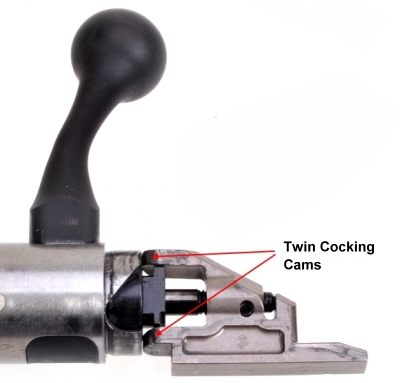
Locking lug count, width and placement determine lift. The action’s cartridge length accommodation, and lift, determine throw. To further improve lift, and therefore throw, Ruger designed in twin cocking cams to increase mechanical advantage, to reduce required effort.
The barrel’s muzzle is threaded to accept muzzle devices. Yes, brakes and silencers. When I work with a rifle that has threads, I always hang a silencer on it and shoot suppressed. Does not hurt accuracy, or velocity, and I can still watch TV without turning the volume up all of the way.
The Predator stock is modular and adaptive in manufacturing. With Power Bedding, common barrel profiles and interchangeable magazine inserts, Ruger can make long, cost effective production runs, while offering a multitude of chambers and a low price to its customers.
The result is a rifle that can be taken hunting for a lifetime, taken to the range with frequency, and still be passed along to the next generation of hunters. Is there a downside? That depends on your perspective. Doesn’t everything?
I am a Mauserly Walnut snob; love control feed Mauser type actions and love fancy walnut. So I am a big Ruger M77 Hawkeye fan. They are also reliable, accurate and, of greatest importance, good looking.
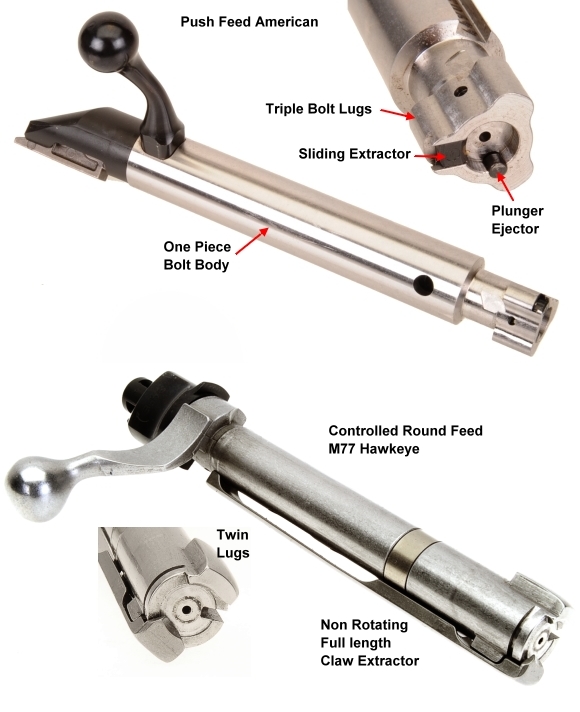
How about the M77 control feed versus the Predator and other Americans push feed? As a practical matter, no difference and the Ruger American Predator rifles have a smoother throw. How about the M77s blade ejector versus the Predator’s spring loaded plunger ejector. I do prefer the blade type because I am a handloader and I hate crawling around in the grass looking for $1.50/case brass.
How about the Ruger M77’s proprietary scope ring system Vs the Ruger American Predator’s Picatinny rail or use of traditional two piece bases? Tough one. The Ruger system is stout, clean and simple. Plus, Ruger includes these rings with the M77, and they will exchange them through customer service if a different diameter/height is needed. Of course, they can also be purchased independent of the firearm.
I kind of like rails these day, as they fit my system. They offer a range of ring placement that accommodates whatever type and vintage of scope I wish to install… “wish” is an odd word. I don’t think I am attempting to conjure a genie, no coins tossed in a fountain. No, not wish. I can mount whatever scope and wings I damn well choose. Beside, I leave optimal ring selections on my scopes, so I can easily move them from one rifle to another, without scrounging around on the shop floor for escaping Torx head fasteners.
M77 hinged floorplate compared to the Ruger American Predator’s detachable magazine? I like the hinged floorplate. It’s fun to push that little recessed release in the front of the Hawkeye’s trigger guard. Sort of like a secret compartment and it feels substantial. But I have never pressed the release on a detachable magazine and had cartridges fall to the ground.
What about the scalloped stock gripping surfaces on the Ruger American Predator Vs the fully checkered surfaces on the M77? The M77 definitely looks better, but the scalloped surfaces definitely grip better in wet weather and in sweaty hands, as well as during Maine’s subzero winters.
What is the plus/minus answer? I have no idea, so I shoot both. If I want to go to the range or spend time in the woods and not worry about the rifle sustaining aesthetic damage, I take a Ruger American Predator. If I want to smile and invite a sense of nostalgia, I take a walnut stocked M77. It’s like listening to Elise LeGrow’s cover of “Going Back Where I Belong” or the original by Sugar Pie DeSanto. Yes it is. Exactly like that.
The 22-250 Remington… The 220 Swift’s Little Brother
 I posted notice of a 270 Winchester based article on Facebook, and someone immediately commented that the 7mm Remington Magnum was the minimum cartridge for deer. So I replied with a picture of a deer, next to a giant brown bear, and asked if he could identify which was the deer.
I posted notice of a 270 Winchester based article on Facebook, and someone immediately commented that the 7mm Remington Magnum was the minimum cartridge for deer. So I replied with a picture of a deer, next to a giant brown bear, and asked if he could identify which was the deer.
Seems the objective of a shot taken is for the bullet to penetrate a vital organ with a wound channel large enough to promote free bleeding. No amount of magnum will make up for a poorly placed shot.
Pictured, 223 Remington, 22-250 Remington, 220 Swift. A friend of mine, in the old days, was an accomplished gunsmith and hunter. His deer rifle was a 20″ barrel bolt action, chambered for the 222 Remington, and he always got a deer without a lot of fuss.
| Cartridge | Case Capacity Grains |
SAAMI MAP KPSI |
Bullet Weight Grains |
SAAMI 24″ Barrel Standard MV FPS |
| 222 Remington | 26.9 | 50 | 55 | 3000 |
| 223 Remington | 28.8 | 55 | 55 | 3215 |
| 22-250 Remington | 43.5 | 65 | 55 | 3650 |
| 220 Swift | 47.0 | 62 | 55 | 3650 |
Successful deer hunting with a .22 caliber centerfire cartridge appearing on the table, is very much dependent on bullet selection. This basically means avoiding explosively expanding varmint bullets, as well as non-predicatively expanding match bullets.
I am a big fan of the 220 Swift. There are those who would say, pointing to the 22-250 Remington’s higher pressure ceiling, that the 22-250 Rem is as fast as the Swift, and will not cause as much barrel erosion. Well, the pressure difference is not significant, and essentially non-existent in factory loaded and handloaded ammunition.
I shoot both cartridges, and have found zero difference in throat or bore erosion when loaded to the same levels. Actually, for those who can resist temptation, and load to 95% of potential, the Swift isn’t bad on barrels. But that is like having 1,000 horse powder on tap and never stepping on the gas.
All that said, when I put together centerfire rifles in recent years, I went with the 22-250 because brass and ammo were readily available. When I selected barrels, they always had a significantly tighter rate of twist than the standard 12″-14″ to facilitate use of heavy for bore bullets. Some as tight as 1:9″, I wasn’t particularly happy with the results, as the tight twist pushed up pressure a bit, and heavy bullets tended to work in opposition to the centerfire .22s high velocity claim to fame.
The Ruger American Predator’s optimal 22-250 Rem solution
|
Ruger American Predator |
|
| Company | Ruger |
| Model Designation | 6945 |
| Point of Manufacture | Newport, NH, USA |
| Type of Action | Bolt Action 3 Lug 70º Lift |
| Caliber | 22-250 Remington |
| Magazine Capacity | 4 |
| Magazine Type* | Single Column Box Detachable |
| Barrel Length | 22″ |
| Rifling Twist Rate | 1:10″ 5 Groove RH |
| Barrel Muzzle Threads | 1/2″-28 |
| Barreled Action | Alloy Steel – Blued Matte Black |
| Stock Type | Moss Green Synthetic |
| Length of Pull | 13.75″ |
| Drop at comb | 5/8″ |
| Drop at heel | 3/4″ |
| Trigger Guard Material | Polymer |
| Front Sight | N/A |
| Rear Sight | N/A |
| Scope Accommodation | Receiver Top Rail |
| Trigger Pull | 3 To 5 Lbs |
| Weight of Firearm | 6.6 Lbs |
| Overall Length | 42″ |
| Safety | Tang |
| MSRP | $619 |
For the deer hunter, the preoccupation with 400 – 500 yard shooting can be set aside. Winchester’s 22-250 Rem deer load is 64 grains with a MV of 3500 fps, where a 300 yard limit is probably reasonable.
| Winchester 54 grain Power Point | |||||||
| Near-Zero – yards. | 30 | Mid Range – yards. | 153 | ||||
| Far-Zero – yards. | 263 | Max Ordinate – “ | +3.0 | ||||
| Point Blank – yards. | 279 | ||||||
| Best Zero : Range 0 – 300 yards | ||||||||
| Yards | 0 | 50 | 100 | 150 | 200 | 250 | 300 | |
| Velocity – fps | 3500 | 3265 | 3043 | 2833 | 2631 | 2438 | 2254 | |
| Energy – ft.-lbs. | 1741 | 1514 | 1316 | 1140 | 984 | 845 | 722 | |
| Momentum – lbs-sec | 32 | 30 | 28 | 26 | 24 | 22 | 21 | |
| Path – “ | -1.50 | 0.84 | 2.36 | 2.94 | 2.44 | 0.68 | -2.54 | |
So, point blank range is 279 yards where the does not rise more than 3″ above line of sight, and falls less than 3″ at 300 yards. Basically, that means of you live in Maine, you should get a deer tag for New Hampshire.
But, Joe, the bullet falls below 1,000 ft-lbs of KE at 200 yards. We all know it is impossible to down a deer with 1,000 ft-lbs of KE. Yeah, about that… A 44 Mag deer load has only 635 ft-lbs of KE at 100 yards and hardly anyone blinks at taking a deer at 100 yards with a 44 Mag. At 300 yards, not only will the 22-250 Rem deliver greater kinetic energy on target, than the 44 Mag at 100 yards, but it will expand to at least .35 caliber and penetrate more deeply.
What next!..!!
I am going to post handload data for the 22-250 that produces 4,000 fps with an 80 grain bullet. No, not really. I will post handload data that will be effective out to 300 yards on deer. I was going to do that in this Part I, but it appears portion 2 of the spare ribs is ready to be pulled from the oven. Part II – coming soon.

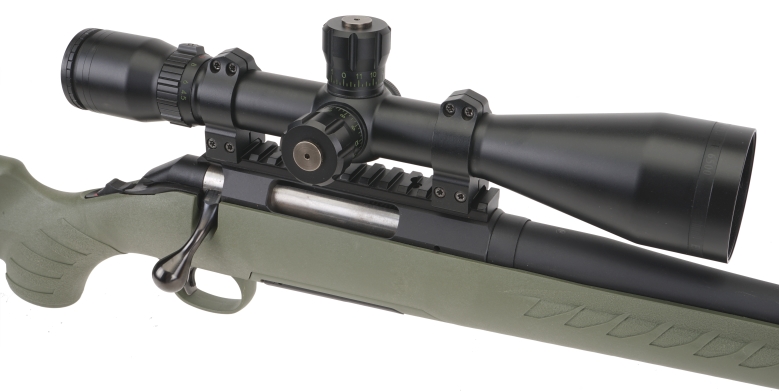
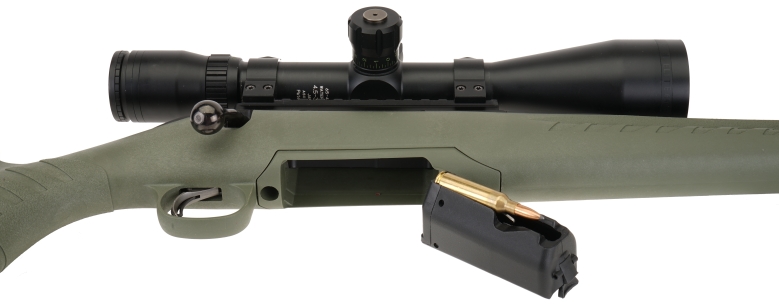

Joe , Great write up on the Ruger in 22-250. My question , How does the magazine handle Ackley cartridges ? I have had the 22-250 Ack. before in TC Encores , but no longer have the guns. I still have the components, ammo & dies. I’ve looked at this rifle ,along w/ this cartridge for a while now, having sold my primary deer rifle in 308 Win . I’ve had both shoulders replaced & want to stay away from much recoil now ( yes I could load them down but…). I really enjoy your articles . Martin
Martin, I would guess the lesser taper and sharper shoulder would feed well from the magazine. The more tapered, more shallow angle shoulder causes bullets to contact relatively low in the barrel extension, the AI would contact slightly higher at an even better feed angle. Speculation on my part.
I’ve owned Ruger American rifles in .308, 300 Blackout, .223 Remington and 7.62 x 39 Russian and all have been exceptionally accurate. With the exception of the 300 Blackout, which inexplicably and erratically would fail to fire, all have been outstanding values. Though not as handsome, they were more accurate than all my Model 77 Hawkeyes. Great rifles, whether you are a novice or expert.